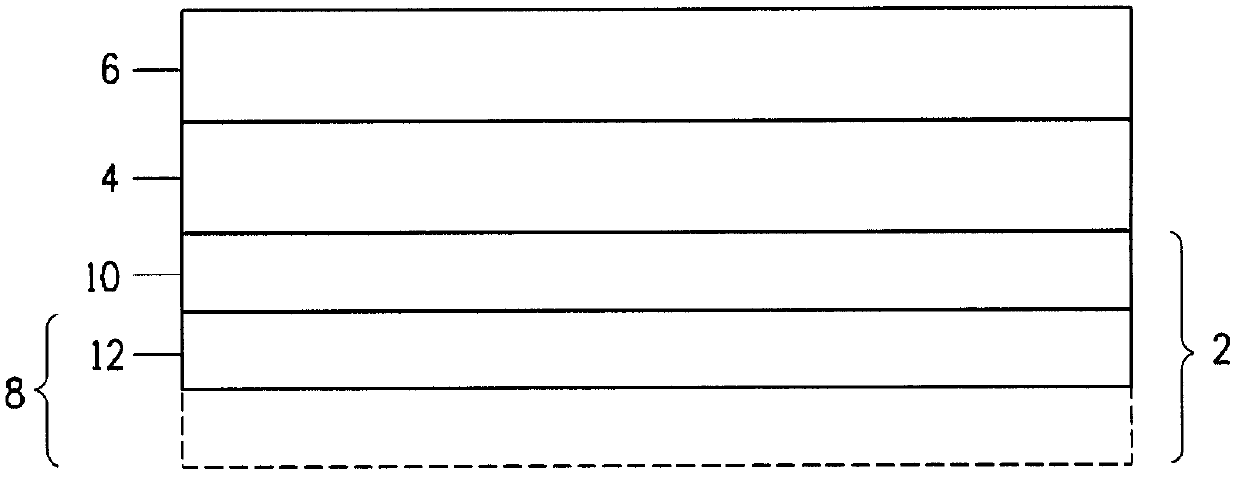Thin film capacitor and method of fabrication thereof
A capacitor and electrode technology, which is applied in the field of film capacitors and the manufacture of such capacitors, can solve the problems of lowering the oxygen partial pressure and the upper limit of the processing temperature, weakening the mechanical stability of the foil, reducing the conductivity and strength, etc.
- Summary
- Abstract
- Description
- Claims
- Application Information
AI Technical Summary
Problems solved by technology
Method used
Image
Examples
example 1
[0056] A 75 micron thick Ni 270 foil in cold rolled condition from HPM (Lancaster PA) was cut into strips measuring 3" x 8.5". 10 mTorr Ar-4% H flowing through a cryogenically pumped stainless steel chamber 2 , the central 3" x 6" area of the bar was resistively heated at 1000°C for 30 minutes. This approach results in a recrystallized microstructure comprising cylindrically bounded grains whose boundaries extend from the top surface to the bottom surface of the foil.
[0057] At this point the foil is secured to a plastic plate and connected to a DC power source, becoming the anode in an electrochemical cell; it is then partially submerged in 60 vol% H 2 SO 4 and 200 mL / L glycerin, leaving the top 1" x 3" area out of the bath. A 3″ x 8.5″ Ni 270 plate was connected to the other terminal of the DC power supply to serve as the cathode, which was then also immersed in the solution, facing the anode, with a spacing of 2″. Then thermostatically regulated by a helical plastic ...
example 2
[0064] As-cold rolled 75 μm thick Ni 270 foil from HPM (Lancaster, PA) was cut into strips measuring 3" x 8.5". The foil was then fixed to a plastic plate and connected to a DC power source, becoming the anode in an electrochemical cell, which was then partially submerged in 60 vol% H 2 SO 4 and 200 mL / L glycerin, leaving the top 1" x 3" area out of the bath. A 3″ x 8.5″ Ni 270 plate was connected to the other terminal of the DC power supply to serve as the cathode, which was then also immersed in the solution, facing the anode, at a distance of 2″. Then thermostatically regulated by a helical plastic coil The solution, the coil use circulating water maintained at 20°C by an external heat exchanger. The bath is also stirred evenly with bubbling nitrogen. Then at 300mA / cm 2 The Ni 270 substrate was electrochemically polished for 20 min. This protocol will produce a mirror-like surface with a roughness rms less than 20 nm for a surface profile sampling length of about 71 micr...
example 3
[0072] As-cold as-rolled 75 micron thick Ni 270 foil from HPM (Lancaster, PA) was cut into strips measuring 3" x 8.5". 10 mTorr Ar-4% H flowing through a cryogenically pumped stainless steel chamber 2 , the central 3" x 6" area of the bar was resistively heated at 1000°C for 30 minutes. This approach results in a recrystallized microstructure comprising cylindrically bounded grains whose boundaries extend from the top surface to the bottom surface of the foil.
[0073] At this point the foil is secured to a plastic plate and connected to a DC power source, which becomes the anode in an electrochemical cell, which is then partially submerged in 60 vol% H 2 SO 4and 200 mL / L glycerin, leaving the top 1" x 3" area out of the bath. A 3″ x 8.5″ Ni 270 plate was connected to the other terminal of the DC power supply to serve as the cathode, which was then also immersed in the solution, facing the anode, at a distance of 2″. Then thermostatically regulated by a helical plastic co...
PUM
| Property | Measurement | Unit |
|---|---|---|
| thickness | aaaaa | aaaaa |
| thickness | aaaaa | aaaaa |
| thickness | aaaaa | aaaaa |
Abstract
Description
Claims
Application Information
 Login to view more
Login to view more - R&D Engineer
- R&D Manager
- IP Professional
- Industry Leading Data Capabilities
- Powerful AI technology
- Patent DNA Extraction
Browse by: Latest US Patents, China's latest patents, Technical Efficacy Thesaurus, Application Domain, Technology Topic.
© 2024 PatSnap. All rights reserved.Legal|Privacy policy|Modern Slavery Act Transparency Statement|Sitemap


